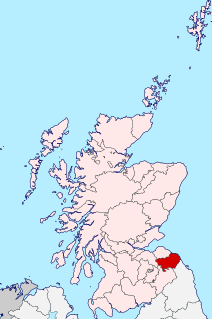
The counties or shires of Scotland are geographic subdivisions of Scotland established in the Middle Ages. Originally established for judicial purposes, from the 17th century they started to be used for local administration purposes as well. The areas used for judicial functions (sheriffdoms) came to diverge from the shires, which ceased to be used for local government purposes after 1975 under the Local Government (Scotland) Act 1973.

Berwickshire is a historic county, registration county and lieutenancy area in the Scottish Borders. It takes its name from Berwick-upon-Tweed, which was part of Scotland at the time of the county's formation, but became part of England in 1482 after several centuries of being fought over and swapping back and forth between the two kingdoms.

Roxburgh, also known as Rosbroch, is a civil parish and now-destroyed royal burgh, in the historic county of Roxburghshire in the Scottish Borders. It was an important trading burgh in High Medieval to early modern Scotland. In the Middle Ages it had at least as much importance as Edinburgh, Stirling, Perth, or Berwick-upon-Tweed, for a time acting as de facto capital.

Berwick-upon-Tweed is a constituency represented in the House of Commons of the UK parliament by an elected Member of Parliament (MP). Since 2015 this MP has been Anne-Marie Trevelyan of the Conservative Party who succeeded the longest serving Liberal Democrat MP Sir Alan Beith who stood down prior to the 2015 election.
Haddington Burghs was a Scottish district of burghs constituency of the House of Commons of Great Britain from 1708 to 1801 and of the House of Commons of the United Kingdom from 1801 until 1885. It elected one Member of Parliament (MP) using the first-past-the-post voting system.
The Scottish representatives to the first Parliament of Great Britain, serving from 1 May 1707 to 26 May 1708, were not elected like their colleagues from England and Wales, but rather hand-picked.

Berwick Castle is a ruined castle in Berwick-upon-Tweed, Northumberland, England.
Tain Burghs, was a constituency of the House of Commons of the Parliament of Great Britain from 1708 to 1801 and of the Parliament of the United Kingdom from 1801 to 1832, sometimes known as Northern Burghs. It was represented by one Member of Parliament (MP).
Wigtown Burghs, also known as Wigton Burghs,. was a constituency of the House of Commons of the Parliament of Great Britain from 1708 to 1800 and of the House of Commons of the Parliament of the United Kingdom from 1801 to 1885. It was represented by one Member of Parliament (MP).

The border between England and Scotland runs for 96 miles (154 km) between Marshall Meadows Bay on the east coast and the Solway Firth in the west.
The Berwick-upon-Tweed by-election, 1973 was a parliamentary by-election held on 8 November 1973 for the House of Commons constituency of Berwick-upon-Tweed. It was one of four UK by-elections held on the same day.

In July 1482 an English army invaded Scotland during the Anglo-Scottish Wars. The town of Berwick-upon-Tweed and its castle were captured and the English army briefly occupied Edinburgh. These events followed the signing of the Treaty of Fotheringhay, 11 June 1482, in which Alexander Stewart, Duke of Albany, the brother of James III of Scotland declared himself King of Scotland and swore loyalty to Edward IV of England. The follow-up invasion of Scotland under the command of Edward's brother, Richard, Duke of Gloucester failed to install Albany on the throne, but Berwick has remained English ever since the castle surrendered on 24 August 1482. The English army left Edinburgh with a promise for the repayment of the dowry paid for the marriage of Princess Cecily of England to the Scottish Prince.
Campbeltown was a royal burgh that elected one Commissioner to the Estates of Scotland between 1700 and 1707.

A commissioner was a legislator appointed or elected to represent a royal burgh or shire in the pre-Union Scottish Parliament and the associated Convention of the Estates. Member of Parliament (MP) and Deputy are equivalent terms in other countries.
Renfrew was a royal burgh that returned one commissioner to the Parliament of Scotland and to the Convention of Estates.
The Liberties of Berwick are coterminous with the parish of Holy Trinity and St. Mary. They comprise the town of Berwick-upon-Tweed and a rural area to the north and west. For several centuries the Bounds of the liberties have been ridden on horseback each year on May Day.
Tarbertshire, or the sheriffdom of Tarbert, was a shire of Scotland until 1633, when it was annexed to Argyllshire. It comprised the mainland peninsula formed by Knapdale and Kintyre, together with the southern Inner Hebrides to the west. It has been suggested that Robert the Bruce, who extended Tarbert Castle, created or intended a sheriffdom there; however, the first reference to Tarbertshire is in 1481, when Knapdale was transferred to it from Perthshire. The shire town was Tarbert, but the sheriff court was latterly at Inveraray in Argyllshire. The Earl of Argyll family of Campbells often supplied the Sheriff of Tarbert and other officials of both Argyll and Tarbert.











